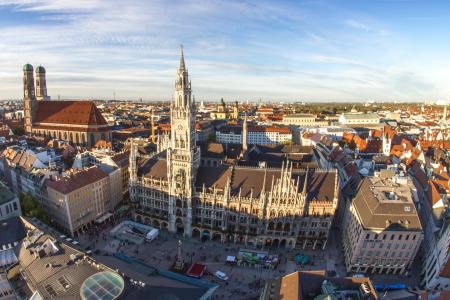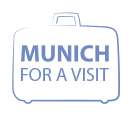Marienplatz
Marienplatz
In the city centre of Munich the Marienplatz (Mary’s Square) is the central square. There is also an important transportation hub for public transport below the surface. On Marienplatz meetings and manifestations take place. Together with the buildings around the square it is the heart of the Bavarian metropolis. The two biggest shopping streets are crossing at Marienplatz, too.
Marienplatz is a very lively place full of surprises. Reaching the square by the escalator from the U- and S-Bahn everything can come about: a prayer for peace of one of the many religious groups in Munich, a manifestation of a political party with a well known politician, buskers and street artists, concerts, important religious personalities, football championship celebrations of the FC Bayern and a lot more.
Buildings and places of interest at the Marienplatz
Several public and commercial buildings surround Marienplatz: Neues Rathaus (New City Hall) a building in a neo-Gothic style with the Glockenspiel (tower bells), Altes Rathaus (Old City Hall) a building in late Renaissance style with a tower where the toy museum is situated, and big shops like “Ludwig Beck am Rathauseck”, “Galeria Kaufhof”, the big bookshop “Hugendubel”, and the traditional restaurant “Donisl” on the corner of Weinstraße. The restaurant is worth a visit because of the pretty portraits of local Bavarian actors that are placed all around the restaurant. A must-see is also the café Rischart or the Café Glockenspiel. Tables near the windows are much sought-after as one has a beautiful view on the square.
Neues Rathaus (New City Hall) with the Glockenspiel
Between 1867 and 1908 the new city hall (Neue Rathaus) was built by Georg Hauberrisser. In the tower (85m high) of the Neue Rathaus is the famous Glockenspiel. Every day it chimes at 11 a.m. as well as at 12 p.m. and in the summer at 5 p.m., too. The Glockenspiel shows two stories from the 16th century. The top half of the Glockenspiel tells the story of the marriage of the local Duke Wilhelm V to Renata of Lorraine. This is then followed by the bottom half and second story: Schäfflertanz (the coopers´ dance). According to a myth, 1517 was a year of plague in Munich. The coopers are said to have danced through the streets to bring fresh vitality to the fearful people. By the way: When passing around 9 p.m. one should have a look at the tower of the Neue Rathaus. At this time an angel will put the “Münchner Kindl" (a young woman representing the town of Munich) to bed.
Altes Rathaus (Old City Hall)
In the eastern part of Marienplatz the old city hall (Altes Rathau)s is situated. During the 15th century it was built by Jorg van Halspach also called Ganghofer who built the Frauenkirche, too. The building was rebuilt several times. During the Second World War it was destroyed and rebuilt in the 1970’s. Today Alte Rathhaus can be booked for presentations. In its tower is the toy museum which is open daily from 10 a.m. to 5.30 p.m.
Mariensäule (Mary’s Column)
In the centre of Marienplatz is a Marien Column that was erected in 1638 to celebrate that Munich was not destroyed during the Thirty’s Year War. It is topped by a golden statue of the Virgin Mary of bronze. Even today Mariensäule is an important place of the religious life in Munich. Three popes have prayed here during their visit to Munich, one of them was Benedikt XVI. Archbishops will be welcomed and seen of at Mariensäule, too.
Fischbrunnen (Fountain of the fishes)
Another attraction and meeting point is the Fischbrunnen a small fountain at Marienplatz in front of the Neue Rathaus. It was built in 1886 by Konrad Knoll. During the Second World the fountain was completely destroyed and rebuild during the 1950’s. Over the centuries many fountains have been built in this place. The first proof of a fountain is dating back to 1343 when it was called citizen’s fountain. At that time is has been a drawing well that went down to the groundwater. Today Fischbrunnen is a popular meeting point for locals meeting in the city centre.
The history of Marienplatz
In the past Marienplatz was a market square. In medieval times a salt- and grain market was held at the crossing of the salt road and the wine road that is why this place was formerly called Schrannenplatz (old southern German for grain market). In 1315 King Louis enacted a ban to build on Marienplatz. Until today all distances connected to Munich will be measured from Marienplatz.
You can display Google's 3D map by clicking on the image below. A connection to the Google servers is only established with this click. Please read our information on Privacy Policy.



